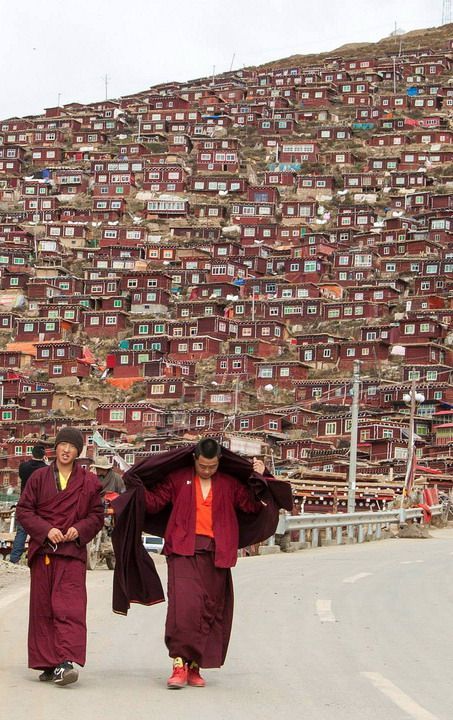High in a treeless valley in China’s remote Garze Tibetan Autonomous Prefecture lies the largest Tibetan Buddhist school in the world – Larung Gar Buddhist Institute. Located in the serene Sêrtar County of China’s Sichuan Province, the Institute is a prestigious known for its traditional and peaceful atmosphere, attracting numerous devotees from around the world. With an enthralling history dating back to the last century, the Institute is one of the largest Tibetan Buddhist institutes globally, offering spiritual learning opportunities to its students.

Beginning in 1980, Khenpo Jikphun, a Tibetan monk, started a small Buddhist School, known as the Serthar Buddhist Institute, in his remote hometown of Sêrtar. The goal was to provide monastic education to the local residents. The school started with just a few dozen students living in makeshift huts, studying Buddhist texts and traditional rituals. Khenpo Jikphun’s dedication and hard work slowly had begun to pay off, gaining popularity with other Tibetans. In the following years, the school grew at an astounding rate, the number of students increased to thousands, its buildings multiplied to almost 10,000, with a student population of almost 40,000.

The religious learning and spiritual practices were open to both male and female students, which was a unique element in Tibetan Buddhism at the time. The Larung Gar Institute upheld the precious human rights of both genders and helped in cracking up the patriarchal system, which was a significant milestone in contemporary Tibetan Buddhism.

The simple huts transformed into Tibetan style log cabins and the institute had its farming fields and workshops for producing handicrafts. In 1999, Khenpo Jigme Phuntsok, the founder of the institute, passed away and the responsibility of managing the institute fell on the shoulders of Khenpo Sodargye, a disciple of Jigme Phuntsok.

Larung Gar Institute is home to numerous Tibetan Buddhist scholars who come from around the world to teach Tibetan Buddhism. It is a prestigious center for Tibetan intellectual attainment, comprising of Tibetan Meditation and Buddha Dharma teachings, training in Buddhist rites, and ceremonies carried out in the Tibetan language, monastic ethics, and underlying principles. Moreover, the principal aim of the institute is to enable people, who are keen on pursuing spiritual growth and self-improvement, to acquire a comprehensive and systematic understanding of the invaluable canonical scriptures of Tibetan Buddhism.

It offers a unique and immersive experience for students of Tibetan Buddhism. Its emphasis on intensive study, debate, and compassion has attracted students fro all over the world, making it one of the most important centers for the study of Tibetan Buddhism in the world today.

How the Monks and Nuns Live in Harmony at Larung Gar
One of the unique features of the Larung Gar Buddhist Institute is the way that monks and nuns live together in harmony. Despite the traditional separation of genders in many Tibetan Buddhist monasteries, Larung Gar has developed a unique approach to coexistence that has inspired many who visit the institute. Here are some of the ways that the monks and nuns live together in harmony at Larung Gar:
- Respect for each other’s autonomy and leadership: Monks and nuns at the institute are treated equally and are free to pursue their own spiritual path without interference from others. Both genders have their own leadership structures and decision-making processes, which are respected by all members of the community.
- Shared living spaces: While there are separate dormitories for men and women, monks and nuns live in the same area and share many common spaces, including the main temple and study halls. This allows for interaction and collaboration between the genders, promoting a sense of community and shared purpose.
- Joint activities and events: The institute holds many joint activities and events that bring monks and nuns together, such as debates, study groups, and prayer sessions. This allows for the development of strong relationships and a sense of shared purpose.
- Emphasis on compassion and non-discrimination: The institute places a strong emphasis on compassion and non-discrimination, which is reflected in its approach to gender equality. Monks and nuns are taught to treat each other with kindness and respect, regardless of gender, race, or background.
- Emphasis on personal responsibility: The institute places a strong emphasis on personal responsibility, with each member of the community expected to take responsibility for their own actions and behavior. This promotes a sense of mutual respect and understanding, which is essential for living together in harmony.
Monks and nuns at Larung Gar live together in harmony through a combination of mutual respect, shared values, and a commitment to personal responsibility. This unique approach to gender equality has inspired many who visit the institute and has helped to promote a sense of community and shared purpose among its members.

